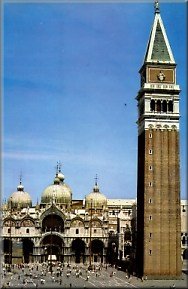| Giovanni Gabrieli (c1557-1612), having spent part of his youth studying with the Flemish composer Orlande de Lassus at the court of the Duke of Bavaria in Munich, retured quite accustomed to the lavish festivities for which he would later be commissioned to compose. Both he and his uncle Andrea Gabrieli (c1553-1585) were native Venetians, both became organists at St. Mark's Cathedral and would perform their music in the artistic treasure-house of the Western World, La Serenissima, the "most serene city" of Venice. |

An early engraving of Gabrieli |
|
| Giovanni in particular would exploit the techniques of cori spezzati ("separated choirs") either of voices, instruments, or a combination of both in a blend of early stereophonic innovation and emotional depth. For, although many of his most spectacular works were intended for the major Christian festivals, even such magnum opuses as "In Ecclesiis" and "Sonata pian e forte" posses a hidden darker quality of intimate syncopation and surprising chromaticism. Unlike his colleagues Adrian Willaert and later, claudio Monteverdi, who recieved elegies and spectacles of unashamed public mourning respecively, Giovanni Gabrieli departed this life unnoticed, together with his music, in 1612. However, in 1615, his friends published his Symphoniae Sacrae II posthumously and his favorite pupil, Heinrich Schutz, himself a respected early Baroque composer, penned the following dedication in his own volume of Symphoniae Sacrae : "At Gabrielius, Dij immortales, quantus vir"; (But Gabrieli, Gods, immortal, what a man!). |

St Mark's Basilica |
|
|
|
||
| St. Mark's Cathedral holds rather a special place in the history of music, as it had not one, but two organ lofts, set up high to the right and left of the alter. Each loft could also hold both singers and instrumentalists, so composers enjoyed writing pieces in which two different groups could be well contrasted. A phrase from the left group would be answered by the same or a different phrase from the right group; there were splendidly powerful effects when both groups played together (tutti). Music written for St Mark's, therefore, always contained contrast. |

A painting of St Mark's |
|